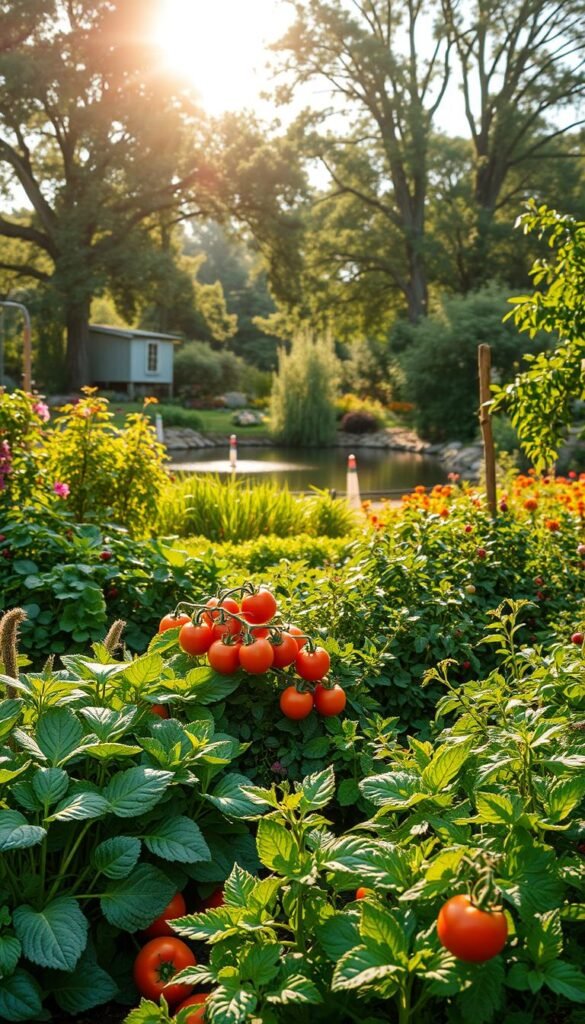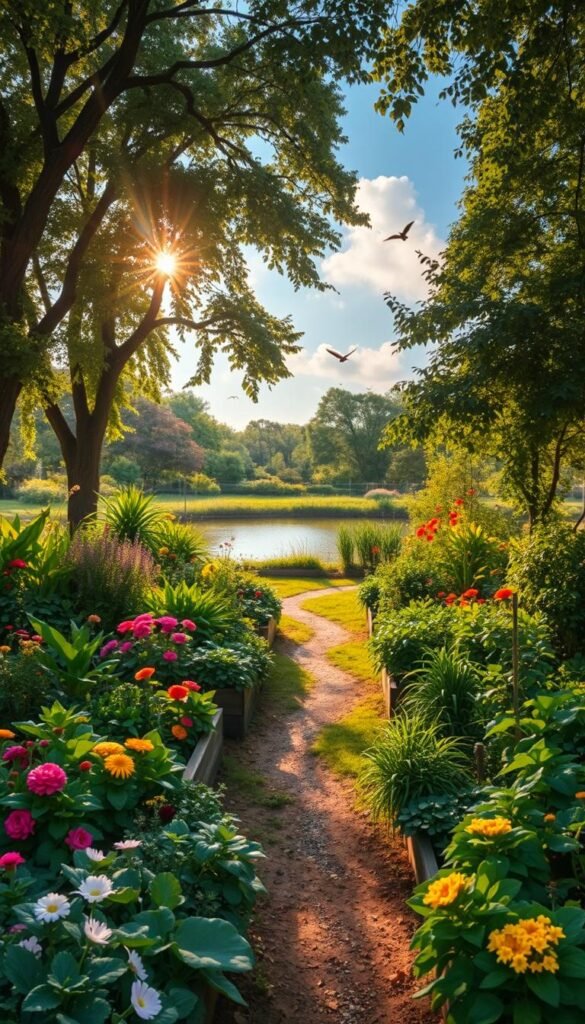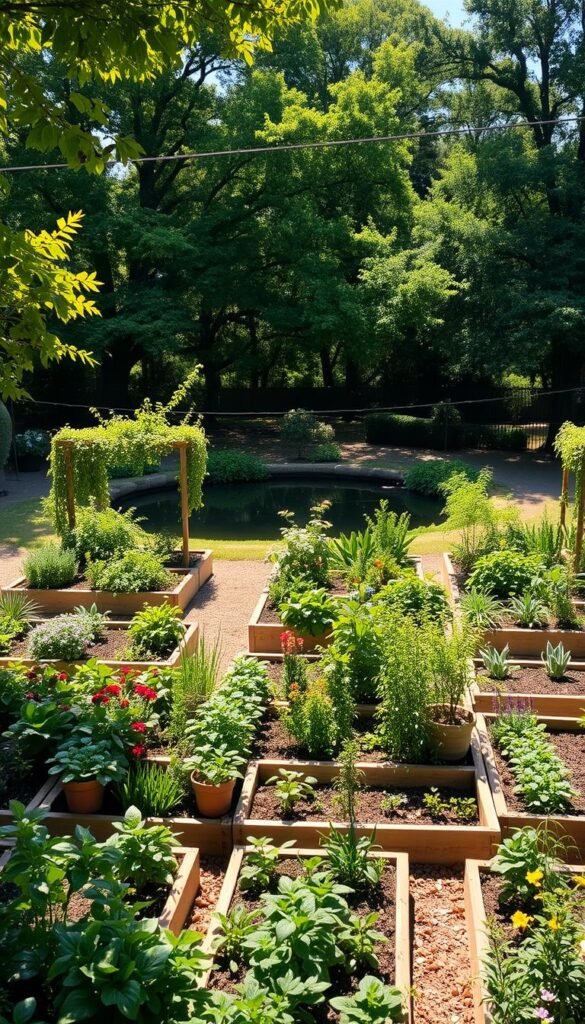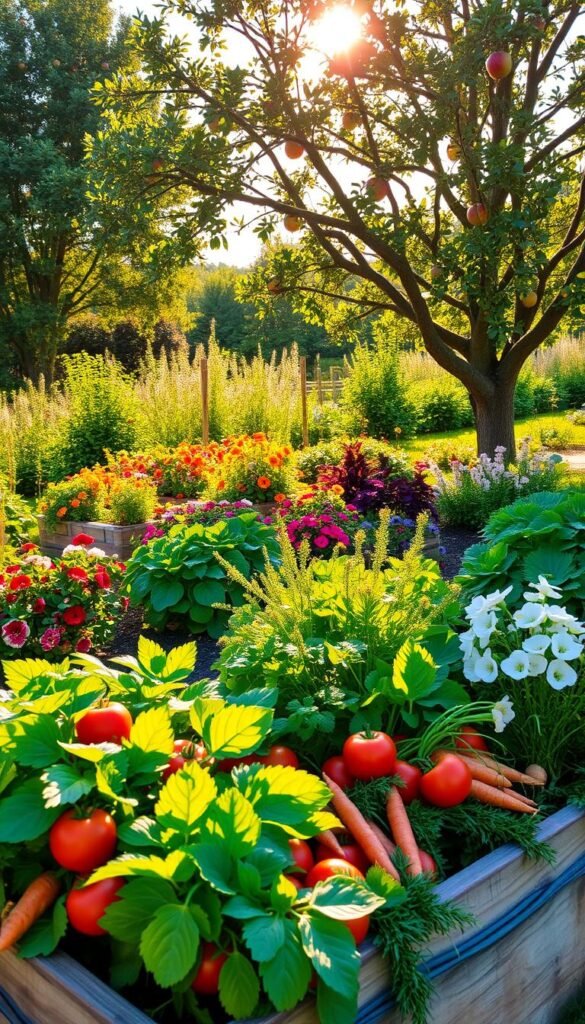Imagine stepping outside to pluck ripe berries from decorative bushes or snip fresh herbs nestled among flowering perennials. Blending beauty with practicality, your yard can become both eye-catching and nourishing through smart plant combinations. This approach lets you grow food while maintaining – or even enhancing – your property’s visual charm.
Whether you have acres of land or just a sunny patio corner, thoughtful arrangements make every inch count. Vertical structures like trellises bursting with beans pair beautifully with low-growing strawberries, while fragrant basil thrives beneath dwarf fruit trees. These layered plantings create textured interest that changes with the seasons.
Beyond fresh produce, your living landscape offers multiple rewards. Pollinators flock to blooming vegetables, while aromatic herbs naturally deter pests. For those seeking deeper ecological integration, consider how a permaculture food forest approach builds self-sustaining ecosystems. Such designs combine edible perennials with beneficial companion species.
This method works across climates and experience levels. Start small with container tomatoes mixed with marigolds, or transform entire yards into productive paradises. As plants mature, you’ll discover new ways to intertwine flavors, colors, and textures – proving functional spaces can be breathtakingly beautiful.
Introduction to Edible Landscaping and Organic Garden Aesthetics

Your backyard could become a living pantry wrapped in nature’s beauty. This method replaces purely decorative shrubs with productive alternatives that feed both eyes and appetite. Instead of separating vegetables from flower beds, they grow together in harmony.
What is Edible Landscaping?
Think ruby-red chard lining walkways or blueberry bushes doubling as privacy screens. Edible landscaping blends fruit trees, herbs, and edible flowers with classic ornamental plants. Grapevines climb arbors while strawberries spill from hanging baskets, proving food growth doesn’t require rigid rows.
Benefits for Your Home and Budget
Beyond fresh salads, you’ll slash grocery costs. A well-planned setup saves $500-$1,000 yearly on produce. Fruit trees become shade providers, while rosemary hedges deter deer better than fences. Even small spaces thrive – window boxes of lettuce mix with pansies create instant edible landscapes.
Pollinators flock to blooming basil, and kids learn biology through cherry tomatoes. Best part? You’re shrinking your carbon footprint with every homegrown pepper. Beauty and bounty aren’t rivals here – they’re partners.
Edible Garden Design 101: Create a Productive Organic Oasis

Transform your outdoor area into a sanctuary that feeds both body and soul. This vision starts by seeing potential in every corner – sunny patches become tomato havens, while shaded nooks host mint and kale. Your space should work with nature, not against it.
Crafting Purposeful Beauty
Forget choosing between pretty and practical. Lavender borders deter pests while attracting bees, and rainbow chard adds pops of color to walkways. These multitasking plants prove functionality and beauty grow together naturally.
Consider these approaches when planning:
| Style | Key Features | Top Plants |
|---|---|---|
| Modern Geometric | Clean lines, raised beds | Espaliered apples, thyme edges |
| Cottage Charm | Curved paths, mixed heights | Climbing beans, nasturtiums |
Your layout should mirror your lifestyle. Frequent entertainers might prioritize patio-adjacent herbs, while families often love snack-friendly berries along play areas. Remember – good design evolves. Start with quick growers like basil and zinnias while fruit trees mature.
Smart layering ensures year-round appeal. Underplant pear trees with shade-tolerant spinach, or let strawberries cascade over retaining walls. As seasons change, so will your landscape’s palette and harvests.
Planning Your Garden: Space, Sunlight, and Soil Considerations

What makes plants thrive in one spot but struggle in another? Your landscape’s success starts with three essentials: smart space use, sunlight patterns, and healthy soil. Let’s turn your property into a living blueprint.
Assessing Your Growing Area and Layout
Grab a tape measure and sketchpad first. Map every wall, path, and existing tree. Vertical surfaces like fences become prime real estate for climbing beans or grapes. Leave 18-24 inch pathways between raised beds for easy harvesting.
“Microclimates near walls can boost tomato growth by 2-3 weeks in cooler regions,” notes a Maryland master gardener.
| Space Type | Planting Solutions | Yield Boost |
|---|---|---|
| Shady Corners | Kale, mint, mushrooms | 30% cooler soil |
| Sloped Areas | Terracing with herbs | 45% less erosion |
Mapping Sun and Shade Patterns
Track light every 2 hours from spring equinox onward. Snap photos at 9 AM, noon, and 3 PM. South-facing zones get 80% more summer sun – perfect for peppers. Use free apps like Sun Seeker to predict seasonal shifts.
Testing and Amending Your Soil
Dig 6-inch samples from five spots. Local extension offices test for $15-$30. Ideal organic matter levels hit 5% – double that with compost if needed. For heavy clay, mix in sand and peat moss over two seasons.
Remember: drainage matters as much as nutrients. After testing, group plants by their needs. Blueberries love acidic zones (pH 4.5), while asparagus prefers neutral ground. Pair these insights with seasonal care strategies for year-round success.
Selecting the Perfect Plants for Year-Round Productivity
Your landscape becomes a living calendar when you choose species that shine in different seasons. Strategic selections ensure something’s always ripe, blooming, or ready to pick – turning your space into a dynamic food source.
Mixing Function and Beauty
Swap dull hedges for rainbow chard borders that dazzle while supplying greens. Train scarlet runner beans up iron trellises – their fiery blooms attract hummingbirds until pods form. Compact bush tomatoes thrive beside lavender, creating purple-and-red vignettes that hide veggie patches in plain sight.
Smart Partnerships in Planting
Pair basil with peppers to boost growth, or let marigolds guard your vegetables from pests. For container setups, try proven plant partners like tomatoes with parsley. Native serviceberries offer three-season appeal: spring flowers, summer fruit, and fiery fall foliage.
Include cold-hardy crops like kale that sweeten after frost. Underplant apple trees with creeping thyme – its flowers feed bees while suppressing weeds. As seasons shift, your living landscape keeps delivering beauty and bites.






